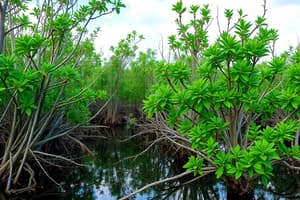Podcast
Questions and Answers
Which type of roots is characteristic of the coastal zone mangroves?
Which type of roots is characteristic of the coastal zone mangroves?
In which zone are plants least tolerant of saltwater?
In which zone are plants least tolerant of saltwater?
Which of the following root structures is associated with the middle zone mangroves?
Which of the following root structures is associated with the middle zone mangroves?
Which tree species is known for having pencil-like roots in the coastal zone?
Which tree species is known for having pencil-like roots in the coastal zone?
Signup and view all the answers
What distinguishes the inland zone from the coastal and middle zones with regard to flooding duration?
What distinguishes the inland zone from the coastal and middle zones with regard to flooding duration?
Signup and view all the answers
What is the function of buoyant fruits in mangrove plants?
What is the function of buoyant fruits in mangrove plants?
Signup and view all the answers
How do Avicennia species manage excess salt?
How do Avicennia species manage excess salt?
Signup and view all the answers
What role do stilt or knee-like roots play in mangrove plants?
What role do stilt or knee-like roots play in mangrove plants?
Signup and view all the answers
Why do some mangrove species have evergreen, waxy, drip tip leaves?
Why do some mangrove species have evergreen, waxy, drip tip leaves?
Signup and view all the answers
What adaptation do Bruguiera, Rhizophora, and Sonneratia species use to deal with excess salt?
What adaptation do Bruguiera, Rhizophora, and Sonneratia species use to deal with excess salt?
Signup and view all the answers
Study Notes
Mangrove Structure and Characteristics
-
Coastal Zone:
- Located closest to the sea
- Flooded by saltwater during high tides
- Plants tolerate high salinity and extended flooding periods
- Avicennia species possess pencil-like breathing roots
- Sonneratia species have cone-like breathing roots
Middle Zone
- Located further from the sea than the coastal zone
- Duration of tidal flooding is shorter compared to the coastal zone.
- Trees feature prop or stilt-like roots extending from their trunks for stability in muddy soil
- Rhizophora species are an example of trees with prop roots
Inland Zone
- Situated furthest from the sea
- Trees exhibit knee-like roots for support on soft soil
- Plants in this zone have the lowest salt tolerance.
- Bruguiera species are characteristic of this zone.
Adaptations of Mangrove Plants
-
Mangrove plants have developed a variety of adaptations to thrive in the challenging environment of saline, oxygen-deprived, and waterlogged soil.
-
Evergreen leaves with waxy coating and drip tips: These features help to reduce water loss through transpiration in the hot, humid climate where they grow.
-
Salt secretion: Avicennia species have specialized glands that allow them to secrete excess salt from their leaves, preventing salt build-up. Salt is removed by wind or rain.
-
Ultrafiltration: Bruguiera, Rhizophora, and Sonneratia species are ultrafiltrators, meaning they prevent excess salt from entering their roots. Excess salt is stored in old leaves which are then shed.
-
Colourful and strong-smelling fruits and flowers: These adaptations attract pollinators for reproduction and dispersal.
-
Buoyant fruits: Mangrove plants are dispersed by water due to their buoyant fruits.
-
Breathing roots (Aerial roots): Mangrove plants have aerial roots that grow above the soil, allowing them to breathe oxygen from the air, despite the oxygen-deprived soil conditions.
-
Stilt/knee-like roots: These roots act as anchors, providing stability in the soft, muddy soil and supporting the plant in waterlogged conditions.
Studying That Suits You
Use AI to generate personalized quizzes and flashcards to suit your learning preferences.
Description
Explore the intricate structure and characteristics of mangroves through this quiz. Learn about the different zones of mangrove ecosystems, including the coastal, middle, and inland zones, and the unique adaptations of species living within these environments. Test your knowledge on the specific plants and their root systems that enable survival in varying salinity and flooding conditions.




